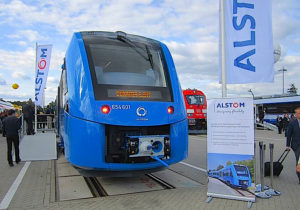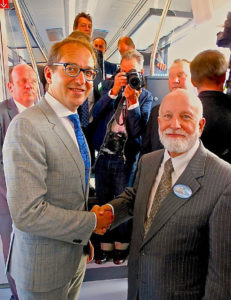Hydrail is the term of art for electrifying railways wirelessly by storing electrical energy onboard as hydrogen and reconverting it, via fuel cells, as needed to power electric traction motors.
In Berlin, Germany, around noon on September 20, 2016, hydrail had its moment in history, reminiscent of May 10, 1869, at Promontory Point, Utah, when the driving of the Golden Spike connected America's east and west coasts by rail.
Hydrail's “Golden Spike” moment was the unveiling of the world's first hydrail train-Alstom Transport's Coradia iLint-at the InnoTrans 2016 railway technology trade fair.
Alstom Transport's Coradia iLint at InnoTrans 2016 - Wikipedia
Hydrail began in “the east” in 1998, when German geophysicist Dr. Holger Busche first proposed that Northern Germany's abundant anticipated wind turbine electric power could be harnessed as electrolyzed hydrogen and used to power passenger trains wirelessly. Hydrail could replace diesel trains, avoiding the prohibitive cost of overhead power, or “catenaries,” and stemming the outflow of national treasure for rail traction energy.
In the “west,” passenger hydrail began in August, 2003, at the US DOT's Volpe National Transportation Systems Center in Cambridge, MA. There I proposed that Vehicle Projects LLC's mining and switch engine fuel cell technology could be adapted for commuter trains, beginning with Mooresville NC. At the Mooresville [NC] South Iredell Chamber of Commerce we named our project “The Mooresville Hydrail Initiative.” Mooresville intended to pioneer the technology world-wide on a 20-mile stretch of commuter rail line to Charlotte.
To sell our skeptical Charlottean neighbors on the idea, we resolved to convene pioneering academics, engineers and others from Japan, Denmark, Canada and elsewhere-along with Federal, State and local authorities-to make the case to the public. Hydrail was bound to happen anyway; why not be first and, by jumpstarting the technology by five or ten years, leave a lot of oil in the ground and keep a lot of CO2 and fine particulate diesel train exhaust out of the atmosphere? To that end, Appalachian State University's Energy Center and the Mooresville Chamber organized a June, 5, 2005, event.
Most funding came from the Bank of America's Enviro-Team. The State of North Carolina, the Centralina Council of Governments and others also chipped in and the US Environmental Protection Agency endorsed the idea. We called the event “The First International Hydrail Conference” or “1IHC” for short.
For political reasons having nothing to do with technology, connecting Mooresville with Charlotte by rail transit was soon ruled out.
But the non-local conferees came motivated by climate and other environmental concerns as well as the extravagant cost of 19th century external (usually overhead) railway electrification-now over US$10 million per mile of track! Appalachian State and the Mooresville Chamber agreed with their perspective; we “went global” to make the inevitable hydrail transition happen much sooner than if left to mere chance.
The next year Denmark hosted “2IHC” and Alstom Transport came and presented their first commercial commuter hydrail design, the “FullTram.”
Each year the IHC's got less hypothetical in content, more inevitable in tone and more international. Finally, at 8IHC (2013) in Toronto, Canada, Alstom Transport of Paris met Hydrogenics Inc. of Mississauga, Ontario. The next year, at Berlin's InnoTrans 2014, they announced they would develop hydrail regional (commuter) trains for four of Germany's Lands (states) and that forty hydrail trains had already been ordered! The trains would be designed and built in Salzgitter, Niedersachsen, Germany.
Mooresville's and Appalachian State University's International Hydrail Conferences strategy for fast-tracking a new generation of “rail tech” had worked! Design and prototype construction began and the result was introduced in Berlin this year.
Germany's Minister of Transportation (left) and Stan Thompson onboard Alstom Transport's first Coradia iLint hydrail train
In 2014, Dr. Holger Busche and Herr Detlef Matthiessen hosted Mooresville's and Appalachian State's Ninth International Hydrail Conference in Neumünster, Schleswig-Holstein, Germany. Herr Matthiessen founded Bündnis 90, Germany's Green Party, and is Bündnis 90's Speaker for Energy and Innovation in the Schleswig-Holstein Parliament. In 2015, both Herr Matthiessen and Dr. Busche came to Mooresville to give presentations at “10-IHC,” the Hydrail Conference's homecoming.
This fall, Dr. Busche-who first conceived passenger hydrail in 1998-and Herr Matthiessen hosted me for the week of InnoTrans 2016. They took me to Berlin for Alstom's Coradia iLint unveiling. There Herr Matthiessen introduced me to Germany's Transportation Minister, Alexander Dobrindt, who was on hand to speak-celebrating the historic event and driving the “virtual Golden Spike.”
The linkage symbolized by the Golden Spike at Promontory Point captured the Nation's imagination and the spread of railways soon transformed American life. Germany as a whole is now considering the possibility of deploying hydrail nationwide. China and Japan may be also.
Early in this century, Congress funded the invention of hydrail. By 2009, Burlington Northern Santa Fe had built an impressive hydrail switch engine, HH 1205. But except for the Mooresville Hydrail Initiative and TIG/m Modern Street Railways' streetcar plant in Chatsworth CA, American hydrail was sidetracked at the end of the Bush years.
Perhaps the Berlin “Golden Spike,” the burgeoning tram industry in China and the role being planned for hydrail at the Tokyo Olympics will help get America back on the hydrogen main line. Alstom has a railway rolling stock plant in Hornell NY and the parent company of both of China's hydrail tram builders has a manufacturing presence in America.
Yet with all the election talk about the “urgency of manufacturing job creation” and “the need for infrastructure modernization,” not one candidate, presidential or down-ticket, seems even aware that all of hydrail's low-hanging fruit is being picked off-shore-though the tree was planted in the USA and fertilized, initially at least, by US tax dollars.
- 0 -
The Twelfth International Hydrail Conference will be held in Graz, Austria, on 26 June 2017. Please visit http://www.hydrail.org next spring for details.



No comments:
Post a Comment